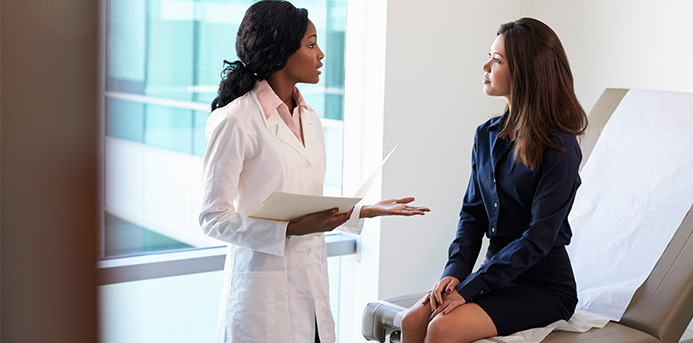When the result of a breast biopsy is benign, it often turns out that the lump is a fibroadenoma, the most common kind of non-cancerous breast lump. Approximately 10 percent of women have fibroadenomas, according to the American Society of Breast Surgeons Foundation (ASBSF).
What are fibroadenomas?
The breast is made up of glandular tissue like milk ducts, connective tissue and fat, and fibroadenomas primarily arise in the connective tissue. That is significant because breast cancer is most often found in the milk ducts. Fibroadenomas are very different from breast cancer and “they cannot really become breast cancer,” says Dr. Swati Kulkarni, MD, breast cancer surgeon at Northwestern Memorial Hospital.
The American Cancer Society (ACS) says fibroadenomas are round and smooth and have distinct borders.
“Fibroadenomas are really common in young women. We frequently see them in women who are in their 20s, 30s and early 40s,” says Kulkarni.
Kulkarni says that while women may think “I have this hard mass in my breast, this is concerning,” she offers assurances that “they really aren’t that worrisome.”
Diagnosis of fibroadenoma
When it comes to diagnosing fibroadenoma, Dr. Claudia Perez, a breast surgeon at Loyola Medicine, says “there is some mixed data and mixed clinical practice.”
She explains that if the mass on an ultrasound is small and has all the features of a benign fibroadenoma, it’s safe to go ahead and follow up in six months with an exam and imaging. “If something feels and looks like a benign mass, then watchful waiting is appropriate,” she says, adding that she is also fine with biopsying a mass that is new when the patient is uncomfortable with waiting.
A biopsy is the only way to provide definitive tissue diagnosis.
Fibroadenoma and breast cancer
There’s some disagreement over what having a fibroadenoma means for a woman’s risk of breast cancer. According to the ACS, having a fibroadenoma raises a woman’s risk of breast cancer to 1 1/2 times that of women with no breast changes. The ASBSF website, however, says that women with simple fibroadenomas and no family history of breast cancer are not at increased risk of breast cancer.
Kulkarni says that if there is an increase in risk, it is not significant.
What causes fibroadenomas?
The cause of fibroadenomas is not known for certain.
“We don’t know why some get them and why some don’t, but we believe they are associated with hormones,” says Kulkarni.
The connection with hormones is supported in part by the fact that fibroadenomas tend to get a little larger when women are pregnant, and often disappear during menopause.
Treatment of fibroadenomas
“If fibroadenomas are stable and not causing any symptoms, we recommend leaving them alone,” says Perez.
If they are causing a patient pain or are growing, however, then removal may be appropriate.
Perez says that while the internet contains information on cryoablation as a treatment, it is “not a common procedure done in the academic institutions at this point. It’s not the standard of care.”

Shannan Younger is a writer living in the western suburbs of Chicago with her husband and teen daughter. Originally from Ohio, she received her undergraduate and law degrees from the University of Notre Dame. Her essays have been published in several anthologies and her work has been featured on a wide range of websites, from the Erma Bombeck Humor Writers Workshopto the BBC. She also blogs about parenting at Between Us Parents.
Shannan is the Illinois Champion Leader for Shot@Life, a campaign of the United Nations Foundation that supports vaccination efforts in developing countries to ensure life-saving vaccines reach the hardest to reach children. “Vaccines are one of the most effective ways to save the lives of children in developing countries and I’d love nothing more than to see diseases eradicated,” Shannan says. “We are so close to getting rid of polio for good!”

